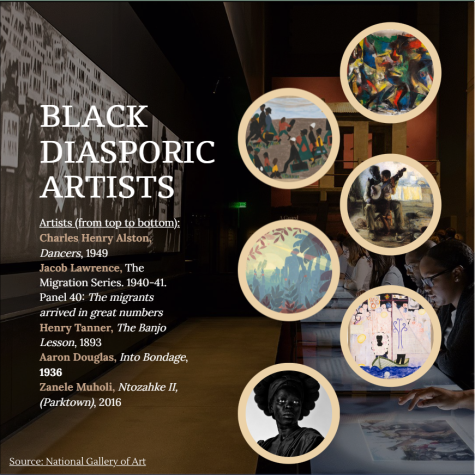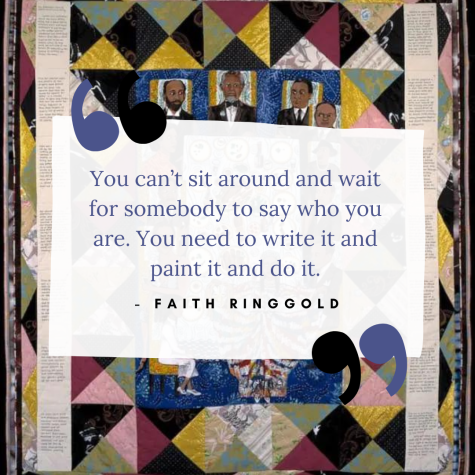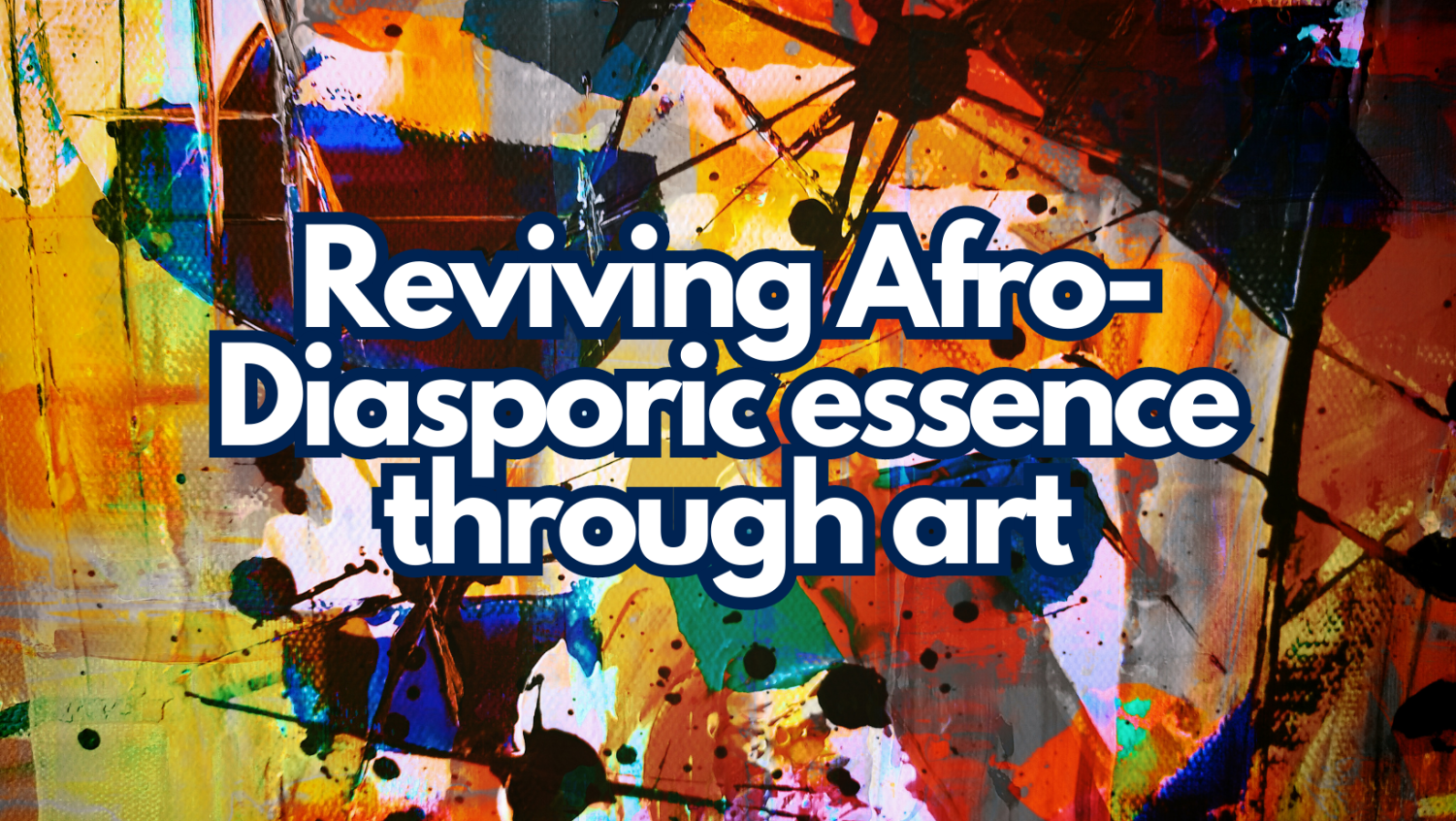Reviving Afro-Diasporic essence through art
May 16, 2023
In the lands of the new world—ideals of free will, nationalism, new opportunities and wealth spark the minds of the masses. The western hemispheric Americas set artistic standards for popular culture worldwide—almost everything on social media and television remains influenced by the expansive mixture of cultural ideals due to European colonization in distinctive manners. Countries such as America, Brazil, Trinidad and Colombia only encompass a compact number of ethnically diverse countries of the West. The list continues on and on, and with that, culture continues to cultivate through artistic expression.
Regarding the mixing pot of the so-called “New World” and the prolonged, persistent quarrel for freedom for Black enslaved communities, modern-day streets of the Western world now overspill with remnants of current Afro-diasporic culture starting in the swinging sixties. A rhythm and blues (R&B) song playing from a car radio, women accessorizing their looks with creatively painted nail extensions, jet black box braids, ginger-colored freeform locs and in-fashioners rocking basketball-inspired fashion and sneakers—this only encompasses a minuscule amount of modern Black culture. Even through the thick and thin of the harrowing struggle for Black freedom through civil rights movements and the complete exposure of Black cultures in Western communities, Black expression of ancient Afro-diasporic cultures remains lost in time—or more so lost to the forced assimilation and destruction of African culture.
“Notwithstanding the memories of slavery, and in the face poverty, ignorance, terrorism, and subjugation still deeply woven into their lives, the embittered past of blacks was taken onto a much higher plane of intellectual and artistic consideration during the Renaissance,” historian Clement Alexander Price said.
1920, in the confined neighborhood of Harlem, New York, Black residents curated the most significant era for Black expression in American history—the Harlem Renaissance. Imagine this: Black women with relaxed and finger-waved dark brown hair and cream-colored dresses join underground galleries that overspill with the sounds of soft saxophones and deep, soulful vocals. Tens of Black Americans silently watch with fond eyes as they analyze new Black art of the decade—the room fills with soft jazz tunes from a live band, and the walls display pieces created by prominent Black artists. The era of the Harlem Renaissance remains a major staple for African-American history, especially in prospects of the rise of art forms that specifically highlight the Afro-diasporic lifestyle.
Known as the “father of African American art,” Harlem artist Aaron Douglas spent his years using traditional art as his muse to highlight the start of the Black American experience. Using influence from West African culture and meshing it with contemporary art forms such as cubism, Douglas remains one of the most influential Black artists of his time. Decades after Douglas’ death, several other artists inspired by him and other Harlem artists took over the art community. For example, contemporary artist Kara Walker highlights black artists in her work using black silhouettes.

The Harlem Renaissance became a massive success. Even though the neighborhood of Harlem only takes up a portion of the Manhattan area, the art and beauty of the movement expanded across the entire African diaspora. It stood as a revival of culture and acceptance, influencing art and media in Black communities. Similarly, at NC, several art students focus their artwork and influences on Black culture, connection and history.
“My artwork is similar in that way, but I don’t usually have deep messages in my paintings. I do however paint people who look like me any chance I get while also creating silly surface-level pieces that don’t really have any deep message when I’m sketching or doodling. It’s of people with features similar to mine like curly hair or brown skin and if not that then it’s people who don’t have Eurocentric features. I think that’s how my ethnic identity influences my art. I love to portray diversity because growing up I didn’t see people like me when watching drawing tutorials on YouTube or in animated TV shows where I liked to draw my favorite characters,” junior art student Samara Weatherly said.
For a magnitude of artists, their identity becomes a staple ingredient for their mixing pot of creativity. And with that, specific identity traits can entirely change an artwork’s portrayal. Especially for Black artists, this continues to hold true. After the era of Jim Crow and during a noteworthy population boom of Black people in east coastal areas, the scope of Black artistry twirled to life. Black joy everywhere—Black citizens living in African-American populated areas gained new freedom of expressing themselves and voicing the thoughts and artistry of their ancestors. Since this joyful era, Black populations continue creating, engaging and prospecting art in a culturally different context than other American groups.
As America modernizes, culture also continues to expand in new worldly ways—and as the culture evolves, an even stronger connection to identity seeps into art and a greater understanding of identity sprouts, repeating the cycle. Through highlighting the unique experience of Black Americans, artists of the new generation find pride in Black prominence, especially by referencing prominent Black figures of the modern day and using colors and hues that highlight the broad spectrum of skin tones Afro-centric people offer.
“If I choose this platform [The Black Arts Movement] and God validates this platform, I feel like we have to use the hyper-reality to get people closer to [actual] reality. Right now is so special because it’s the information age and people just want to be aware and there’s no better way of doing that than through art,” actor Kofi Siriboe said.
In recent times, Black artists seem to focus on a particular type of artistry the most: portrait realism. With a human subject as the focus, one emotion—or maybe, a colleague of emotions that directly correlates—seeps through the art, leaving the aesthete with an opportunity to match the sentiment with the person on paper. While a portrait can seem to focus on one individual and the possible emotions that the artist applied to them, artists who focus on culture use this opportunity to apply a feeling to not just the individual in the portrait, but to a whole community. In Mickalene Thomas’ “A Little Taste Outside of Love,” a nude woman calmly lays on an array of intricate patterns. While the idea of the piece seems simple, the art’s subject reveals much more than presumed. The art piece symbolizes a homage to Black femininity and the objectification Black women face for their bodies. With a passive look on her face, lying comfortably, the subject seems unaware of the sexualization of her body, and the art highlights this notion through her lack of expression. This experience affects not only the subject but the group—in this case, Black women who encounter sexualization due to their bodies.
“I’d actually say that your ideas come from the art collective, those artists that you’ve always been interested in and figuring out what they would do in those situations. That’s what an artist is anyway. He’s just a single member of a collective, the whole generation that went before,” artist Sam Gillian said.
In a more positive light, Black artists also give influential Black figures the spotlight in their artistry. For example, Amy Sherald’s “Michelle LaVaughn Robinson Obama” depicts a modern full-body portrait of former First Lady Michelle Obama. The portrait embodies strength, especially an influential historical moment when Americans gained inspiration from the first Black First Lady. Furthermore, the image holds emotions such as confidence, self-reliance and outlook of the contemporary future of Black Americans in influential spaces.
“I think all forms of art, whether it be composing music, painting or photography and film, are mediums for self-expression. You can see that with the way some people’s entire careers are built around dissecting the meaning of a piece of artwork, and a lot of the times the meaning is built around the creator’s cultural identity,” Weatherly said.
Art does not stop at the paint on canvas. For younger Black artists, the realm of digital and animation draws them in quickly. Digital art leans more toward the bright, perfect line work and smooth animation aspects of art. In these spaces, numerous Black artists create original characters (OCs) that engage in the world from a Black perspective. The accessibility of art online creates an easier ability to present creativity to the world and spreads a personal message. In the Disney Channel show “Proud Family”, the animators focus on animating characters that protrude Black culture, which includes the character’s style, hair, mannerism, accents, facial expressions and so much more. This style of art expression specifically opens a whole world of freedom of expression to a younger audience of Black kids. Not only do shows such as “Proud Family” serve as entertainment, but it also serves as an analysis of a culture and how Black people evolved their cultural identity in a foreign home.
At NC, Black artists of countless arrays gather to use their creative minds to hone their skills in art classes. Contemporary, realism and abstract art blooms on paper—and even on a tablet screen—as artists tell a story with one hand a mind full of experiences that influence their pieces. With more modern influence, several Black artists at NC focus their artistry on portraits and interests that they hold dearly.

When defining the word art, answers vary. According to Britannica, the term relates to “something that is created with imagination and skill and that is beautiful or that expresses important ideas or feelings.” In this case, art varies from almost any field of expression, including sharing feelings in visible form. While the human experience includes experiencing various emotions, what causes these feelings depends on different experiences, including ethnic culture.
Regarding the complexity of the Black American experience, a history of oppression, prejudice, loss of culture and disregard curates the backbone of negative emotions this community continues to face. Although these negative experiences bring in positive ones, feelings of Black joy and love for African-American lifestyles as the culture expands. Black artists highlight these emotions through traditional art, animation, photography, creative writing, poetry and music, in turn creating a safe space for Black culture to expand by highlighting the crucial feelings Black Americans experience in their day-to-day lives.

